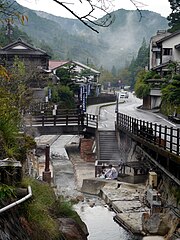
Tourism in Japan is a major industry and contributor to the Japanese economy.

Wakayama Prefecture is a prefecture of Japan located in the Kansai region of Honshu. Wakayama Prefecture has a population of 944,320 and has a geographic area of 4,724 square kilometres (1,824 sq mi). Wakayama Prefecture borders Osaka Prefecture to the north, and Mie Prefecture and Nara Prefecture to the northeast.
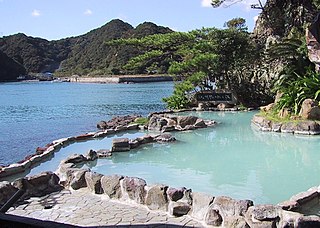
In Japan, onsen are the country's hot springs and the bathing facilities and traditional inns around them. As a volcanically active country, Japan has many onsens scattered throughout all of its major islands. There are approximately 25,000 hot spring sources throughout Japan that provide hot mineral water to about 3,000 genuine onsen establishments.

Owase is a city located in Mie Prefecture, Japan. As of 1 August 2021, the city had an estimated population of 16,910 in 9177 households and a population density of 88 persons per km2. The total area of the city was 192.71 square kilometres (74.41 sq mi).
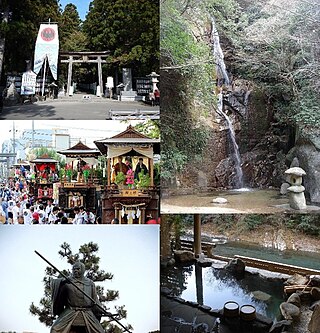
Tanabe is a city located in Wakayama Prefecture, Japan. As of 1 November 2021, the city had an estimated population of 70,972 in 35076 households and a population density of 69 persons per km². The total area of the city is 1,026.91 square kilometres (396.49 sq mi). Tanabe is the second largest city in Wakayama in terms of population, and the largest in the Kansai region of Japan in terms of area.

Shingū is a city located in Wakayama Prefecture, Japan. As of 1 November 2021, the city had an estimated population of 27,491 in 14649 households and a population density of 110 persons per km². The total area of the city is 255.23 square kilometres (98.54 sq mi). Shingū literally means 'New Shrine' and refers to Hayatama Shrine, one of the Three Grand Shrines of Kumano (See). The 'old shrine' would be Kamikura Shrine.

Nachikatsuura is a town located in Higashimuro District, Wakayama Prefecture, Japan. As of 1 November 2021, the town had an estimated population of 14,420 in 7622 households and a population density of 79 persons per km². The total area of the town is 183.31 square kilometres (70.78 sq mi).

Nachi Falls in Nachikatsuura, Wakayama Prefecture, Japan, is one of the best-known waterfalls in Japan. With a drop of 133 meters, it is the country's tallest water fall with single uninterrupted drop; however, the tallest waterfalls with multiple drops in Japan are Hannoki Falls, at 497 m (seasonal), and Shōmyō Falls, at 350m.

A Kumano shrine is a type of Shinto shrine which enshrines the three Kumano mountains: Hongū, Shingū, and Nachi [Kumano Gongen (熊野権現)]. There are more than 3,000 Kumano shrines in Japan, and each has received its kami from another Kumano shrine through a process of propagation called bunrei (分霊) or kanjō (勧請).

Yoshino-Kumano National Park is a national park comprising several non-contiguous areas of Mie, Nara, and Wakayama Prefectures, Japan. Established in 1936, the park includes Mount Yoshino, celebrated for its cherry blossoms, as well as elements of the UNESCO World Heritage Site Sacred Sites and Pilgrimage Routes in the Kii Mountain Range.

Kumano Nachi Taisha (熊野那智大社) is a Shinto shrine and part of the UNESCO-designated World Heritage Sacred Sites and Pilgrimage Routes in the Kii Mountain Range of Japan. The Kumano Kodō route connects it to other sites under the same classification, which are primarily located in Wakayama Prefecture, Japan. The four sites on the route, classified as pilgrimage destinations and World Heritage Sites, are: 1) Nachi Taisha; 2) Hongū Taisha; 3) Hayatama Taisha; 4) Koya-san.

The Kumano Kodō (熊野古道) is a series of ancient pilgrimage routes that crisscross the Kii Hantō, the largest peninsula of Japan. These trails were used by pilgrims to "Kumano Sanzan" (熊野三山) or the Three Grand Shrines of Kumano: Kumano Hongū Taisha (熊野本宮大社), Kumano Nachi Taisha (熊野那智大社) and Kumano Hayatama Taisha (熊野速玉大社).

Kumano Hongū Taisha (熊野本宮大社) is a Shinto shrine located in the jurisdiction of Tanabe, Wakayama, deep in the rugged mountains of the southeast Kii Peninsula of Japan. It is included as part of the Kumano Sanzan in the World Heritage Site "Sacred Sites and Pilgrimage Routes in the Kii Mountain Range". The main deity enshrined is Kumano Gongen (熊野権現). All of the ancient Kumano Kodō routes lead to the Grand Shrine.
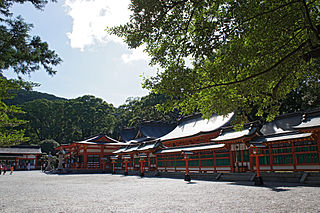
Kumano Hayatama Taisha (熊野速玉大社) is a Shinto shrine located in Shingu, Wakayama Prefecture, on the shores of the Kumanogawa in the Kii Peninsula of Japan. It is included as part of the Kumano Sanzan in the UNESCO World Heritage site "Sacred Sites and Pilgrimage Routes in the Kii Mountain Range". The three Kumano Sanzan shrines are the Sōhonsha of all Kumano shrines, lie at between 20 and 40 km of distance one from the other and are connected by the pilgrimage route known as "Kumano Sankeimichi" (熊野参詣道).

Takanoyu Onsen (鷹の湯温泉) is one of several hot springs in the Akinomiya Hot Springs area of the city of Yuzawa, in southern Akita Prefecture. The onsen is nestled in a small gorge along the banks of the Yakunai River. Because of its secluded location, it is referred to as a Hitou, or hidden hot spring.

Beppu Onsen (別府温泉) is an extensive hot spring system in the city of Beppu, Ōita, Japan. There are eight distinct major thermal spring zones called "Beppu Hatto".

Onsen tamago is a traditional Japanese low temperature egg which is slow cooked in the hot waters of onsen in Japan.

The Iseji (伊勢路) is part of the Kumano Kodõ (熊野古道) pilgrimage route system. It links the Ise Grand Shrine (伊勢神宮) with the three great shrines of Kumano — Hongu, Nachi, and Hayatama Shrines.
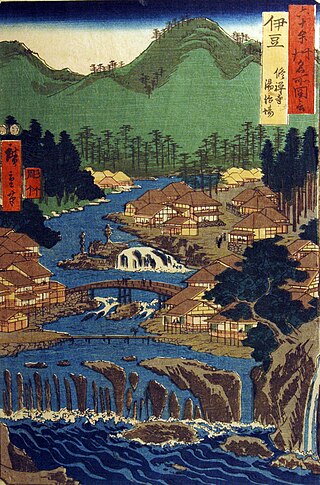
Shuzenji Onsen is a geothermal spring system in the Tagata District of Shizuoka Prefecture, Japan, in the central region of Izu Peninsula.


